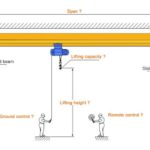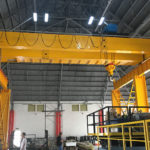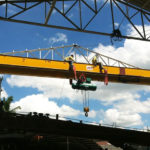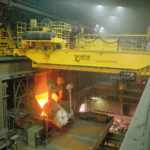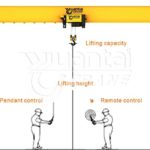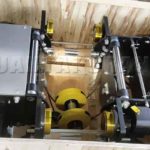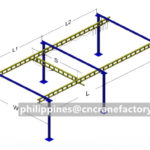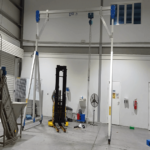Overhead cranes are highly needed for material handling in manufacturing. Whether you’re transporting raw materials, heavy equipment or finished goods, you need the right crane. This article showcases some of the most common crane types used in manufacturing facilities (such as grab overhead cranes, Single Girder Overhead Cranes, underslung cranes, explosion-proof overhead cranes, Portable Gantry Cranes, Portable Jib Cranes, electric chain hoists, etc.) and their advantages, applications, and how to choose the best overhead crane for your needs.
Types of Cranes in Manufacturing
- Grab Bucket Overhead Crane
Grab bucket overhead cranes are indispensable in industries where bulk materials need to be handled efficiently. These cranes feature a specialized grab bucket attachment that enables them to lift and transport loose materials such as sand, gravel, or waste. Operating with precision and speed, grab bucket cranes streamline loading and unloading processes, significantly reducing manual labour and operational costs. - Single Girder Overhead Crane
Single girder overhead cranes are renowned for their versatility and cost-effectiveness. With a single beam spanning the width of the facility, these cranes are ideal for light to moderate lifting tasks. Their compact design makes them suitable for facilities with limited space, offering optimal manoeuvrability without compromising performance. From assembly lines to warehouses, single girder overhead cranes are a popular choice across various manufacturing settings. - Underslung Crane
Underslung cranes, also known as underhung cranes, are engineered to maximize space utilization while maintaining superior load-bearing capacity. Unlike traditional overhead cranes, underslung cranes are mounted beneath the runway beam, allowing for seamless movement along the length of the facility. This unique configuration minimizes interference with overhead obstacles, making underslung cranes ideal for facilities with constrained vertical space or intricate layouts. - Explosion-Proof Overhead Crane
In hazardous environments such as chemical plants or oil refineries, safety is paramount. Explosion-proof overhead cranes are specially designed to operate safely in potentially explosive atmospheres, where flammable gases or vapours may be present. Constructed with robust materials and equipped with advanced safety features, these cranes mitigate the risk of ignition, ensuring the protection of personnel and assets in high-risk environments. - Portable Gantry Crane
Portable gantry cranes offer unparalleled flexibility in manufacturing operations, enabling load handling in diverse locations within the facility. Featuring a movable structure supported by sturdy legs, these cranes can be easily transported and assembled as needed. Whether loading/unloading trucks or moving heavy machinery, portable gantry cranes provide a versatile solution for temporary or ad-hoc lifting requirements, enhancing efficiency and adaptability on the shop floor. - Portable Jib Crane
Compact yet powerful, portable jib cranes are designed for precision lifting in confined spaces. With a rotating boom mounted on a vertical mast, these cranes offer a wide range of motion, allowing operators to manoeuvre loads with ease. From workshops to assembly areas, portable jib cranes excel in tasks that demand agility and precision, providing a reliable lifting solution where traditional cranes may not be feasible. - Electric Chain Hoist
Electric chain hoists are indispensable tools for lifting and positioning heavy loads with precision and control. These compact yet robust devices feature a chain mechanism powered by an electric motor, enabling smooth and efficient vertical movement. With various capacities and configurations available, electric chain hoists are suitable for a wide range of applications, from light-duty lifting in workshops to heavy-duty operations in manufacturing facilities.
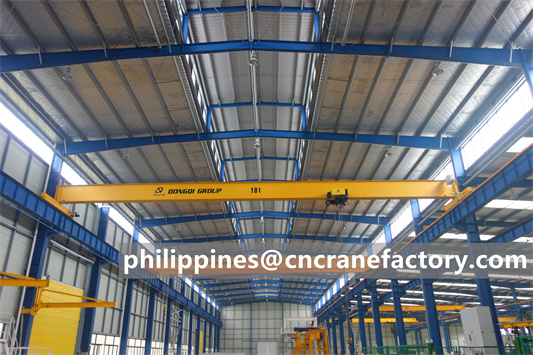
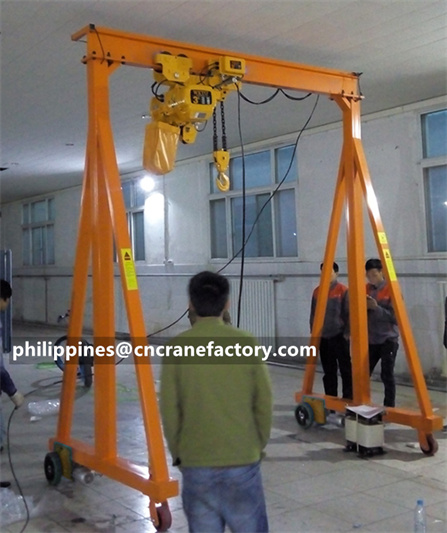
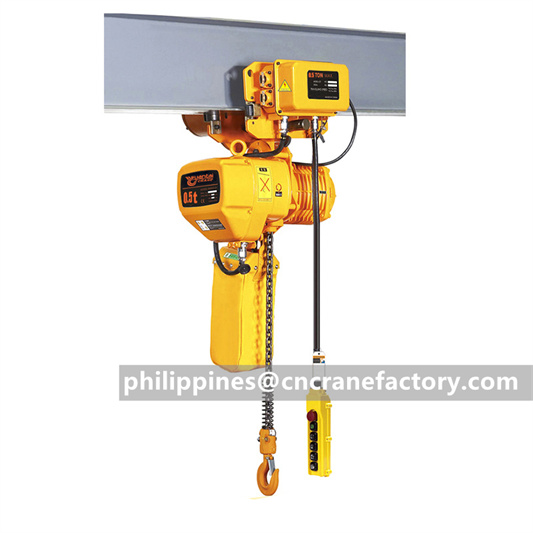
Advantages of Using Cranes in Manufacturing
- Increased Efficiency: Cranes automate the lifting and moving of materials, significantly reducing manual labour and improving production speed.
- Improved Safety: By eliminating the need for manual lifting, cranes minimize the risk of workplace injuries.
- Enhanced Ergonomics: Cranes help to prevent workers from overexerting themselves, reducing fatigue and promoting better posture.
- Versatility: With various types and configurations available, cranes can be adapted to handle a wide range of materials and lifting requirements.
- Precision Lifting: Modern cranes offer precise control over lifting and lowering operations, ensuring safe and accurate material handling.
How Are Cranes Used in Manufacturing?
The specific applications of cranes in manufacturing are vast, but here are some common examples:
- Overhead Cranes: These cranes are used for a variety of tasks, including lifting raw materials from storage, moving heavy equipment within the facility, and positioning parts during assembly.
- Underslung Cranes: They are well-suited for loading and unloading machinery from trucks or trailers, as well as for lifting materials in areas with limited overhead clearance.
- Explosion-Proof Overhead Cranes: These cranes are critical in facilities that handle flammable materials or work with processes that generate explosive fumes. They are commonly found in chemical plants, paint production facilities, and grain elevators.
- Portable Gantry Cranes: These cranes offer temporary lifting solutions for maintenance tasks, equipment installation, or loading and unloading operations in outdoor areas.
- Portable Jib Cranes: Jib cranes excel in workstations where repetitive lifting of smaller loads is required. They are commonly used in machine shops, assembly lines, and engine repair facilities.
- Electric Chain Hoists: Electric chain hoists are often used with jib cranes or monorail systems for lifting lighter loads in workstations or for maintenance purposes.
Choosing the Right Crane Specifications for Manufacturing Needs
Selecting the right crane depends on several factors, including:
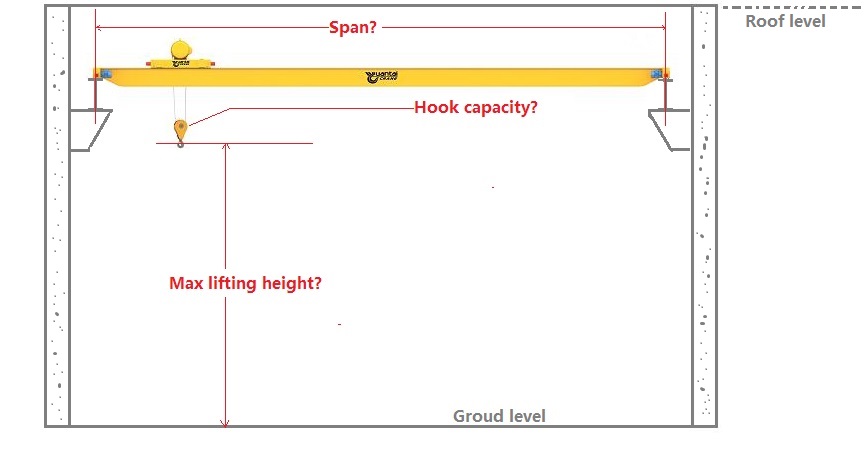
- Lifting capacity: This refers to the maximum weight the crane can safely lift. It’s crucial to choose a crane with a capacity exceeding your heaviest anticipated load. Capacities can vary greatly, with some overhead cranes lifting hundreds of tons, while jib cranes might handle loads in the range of a few thousand pounds.
- Span: This is the horizontal distance the crane can cover. It’s determined by the length of the bridge beam for overhead cranes or the reach of the jib arm for jib cranes.
- •Lifting Height: This specifies the maximum vertical distance a load can be lifted. Factors like building height and clearance limitations will influence your choice.
- Hoist Speed: This determines how fast the crane can raise or lower a load. Selecting the appropriate speed depends on your application. Faster speeds might be necessary for high-volume production lines, while slower speeds might be preferred for precise positioning tasks.
- Duty Cycle: This classification system defines the expected usage pattern of the crane. Light-duty cranes are suitable for infrequent lifting tasks, while heavy-duty cranes are designed for continuous operation in demanding environments.
- Power Source: Cranes can be powered by electricity, hydraulics, or pneumatics. The choice depends on factors like facility infrastructure and the specific application.
- Facility Layout: Consider the available space and ceiling height when selecting a crane type.
- Portability: If you need the crane to be moved around the facility, a portable gantry or jib crane might be a better option.
Maintaining Crane in the Manufacturing Industry
Regular maintenance is vital to ensure the safe and reliable operation of your crane. Here are some key maintenance practices:
- Scheduled Inspections: Regular inspections by a qualified technician are crucial to identify potential issues and prevent breakdowns. These inspections typically involve checking for wear and tear on components, lubrication of moving parts, and ensuring proper functionality of safety features.
- Operator Training: Proper operator training is essential for safe and efficient crane operation. Operators should be familiar with the crane’s limitations, pre-operation checks, safe lifting techniques, and emergency procedures.
- Record Keeping: Maintaining detailed records of inspections, maintenance performed, and any repairs are essential for ensuring the crane’s longevity and compliance with safety regulations.
Additional Considerations of Using Cranes in the Manufacturing Industry
Here are some additional factors to keep in mind when selecting and using cranes:
- Safety Features: Modern cranes come equipped with various safety features, such as overload protection, limit switches, and emergency stop buttons. It’s crucial to ensure all safety features are operational and workers are trained on their proper use.
- Regulatory Compliance: Crane’s operation is subject to safety regulations. It’s essential to be familiar with these regulations and ensure your crane selection, operation, and maintenance practices comply.
- Future Needs: Consider your future needs when selecting a crane. If you anticipate future expansion or heavier lifting requirements, choosing a crane with some excess capacity might be a wise investment.
The Future of Cranes in Manufacturing
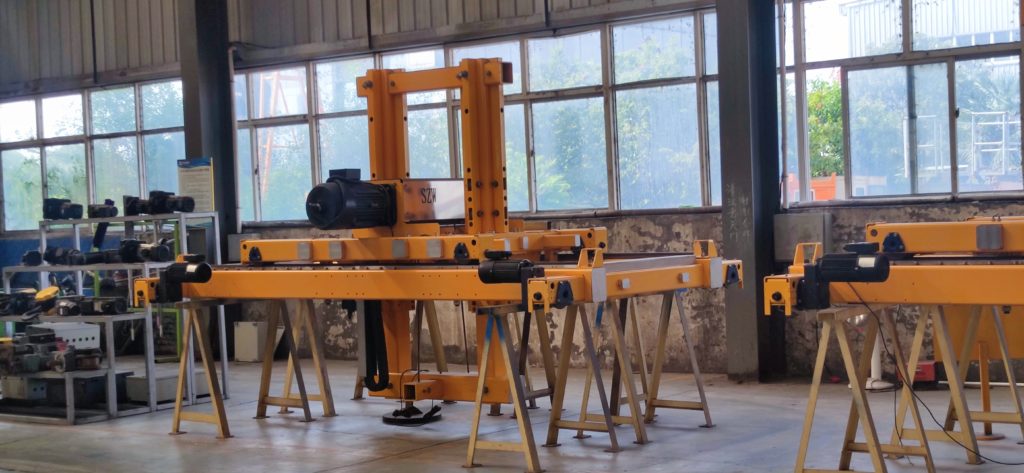
- Smart Cranes: Integration of smart technologies like sensors, data analytics, and machine learning is transforming cranes. These “smart cranes” can collect data on usage patterns, identify potential maintenance needs, and optimize lifting operations for efficiency and safety.
- Remote Operation: Advancements in wireless communication and control systems are paving the way for remote crane operation. This allows operators to control cranes from a safe distance, particularly in hazardous environments or for tasks requiring high precision.
- Automated Material Handling: Cranes are increasingly being integrated into automated material handling systems. These systems utilize software and robotics to automate the entire material handling process, from storage and retrieval to transportation and positioning within the facility.
- Lightweight and Portable Solutions: Manufacturers are developing lighter and more portable crane solutions for greater flexibility. These cranes are easier to set up, disassemble, and move around the facility, catering to dynamic production needs and temporary lifting requirements.
Come and Get a Free Inquiry
Our Yuantai Crane Company has been exporting overhead cranes, gantry cranes, jib cranes and electric hoists to the Philippines and other Southeast Asian countries as well as countries around the world for more than ten years. We have very rich experience and a green crane manufacturing industry chain. contact us to get free crane solutions and free quotations, and look forward to our friendly cooperation!
